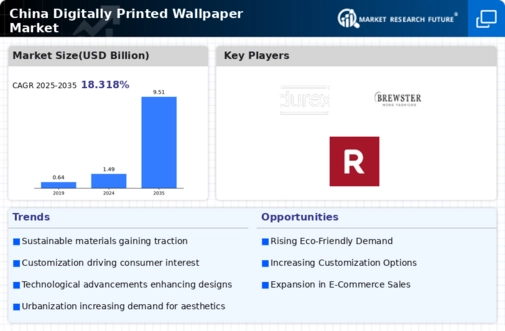Technological Advancements in Printing
The digitally printed-wallpaper market in China is experiencing a surge due to rapid technological advancements in printing techniques. Innovations such as high-resolution printing and eco-friendly inks are enhancing the quality and appeal of wallpapers. The introduction of digital printing technology allows for intricate designs and customization options, catering to diverse consumer preferences. As a result, the market is projected to grow at a CAGR of approximately 10% over the next five years. This growth is driven by the increasing demand for unique and personalized interior designs, which traditional wallpaper cannot fulfill. Furthermore, advancements in printing machinery are reducing production costs, making it more feasible for manufacturers to offer competitive pricing in the digitally printed-wallpaper market.
Consumer Preference for Aesthetic Appeal
In China, there is a noticeable shift in consumer preferences towards aesthetic appeal in home and office decor. The digitally printed-wallpaper market is capitalizing on this trend, as consumers seek unique and visually striking designs that reflect their personal style. The ability to customize wallpapers with specific patterns, colors, and textures is particularly appealing to the younger demographic, who prioritize individuality in their living spaces. Market Research Future indicates that approximately 60% of consumers are willing to pay a premium for customized wallpaper solutions. This growing inclination towards personalized decor is likely to drive the demand for digitally printed wallpapers, positioning the market for sustained growth in the coming years.
Influence of Social Media and Design Trends
The impact of social media on design trends cannot be overstated, particularly in the context of the digitally printed-wallpaper market. Platforms like Instagram and Pinterest are inundated with interior design inspirations, showcasing the versatility and creativity of digitally printed wallpapers. This exposure is influencing consumer choices, as individuals are increasingly drawn to trendy designs that they encounter online. The market is likely to see a rise in demand for wallpapers that align with popular aesthetics, such as minimalism and bohemian styles. As a result, manufacturers are adapting their offerings to cater to these trends, which could lead to a projected market growth of around 7% over the next few years. The digitally printed-wallpaper market is thus becoming more responsive to the dynamic nature of consumer preferences driven by social media.
Rising Urbanization and Real Estate Development
Urbanization in China is a significant driver for the digitally printed-wallpaper market. As more individuals move to urban areas, the demand for residential and commercial spaces increases, leading to a boom in real estate development. This trend is accompanied by a growing interest in interior design, where digitally printed wallpapers are favored for their aesthetic appeal and versatility. The real estate sector's expansion is expected to contribute to a market growth rate of around 8% annually. Additionally, the increasing number of interior design firms and home improvement projects further fuels the demand for innovative wallpaper solutions. Consequently, the digitally printed-wallpaper market is well-positioned to benefit from these urbanization trends.
Environmental Awareness and Eco-Friendly Products
Environmental awareness among consumers in China is shaping the digitally printed-wallpaper market. As sustainability becomes a priority, there is a growing demand for eco-friendly wallpaper options that utilize non-toxic materials and sustainable production processes. Manufacturers are responding by developing wallpapers that are not only visually appealing but also environmentally responsible. This shift is likely to attract a segment of consumers who are willing to invest in sustainable home decor solutions. Market data suggests that eco-friendly products could account for up to 30% of the total wallpaper market by 2027. Consequently, the digitally printed-wallpaper market is poised to benefit from this trend, as it aligns with the increasing consumer preference for sustainable living.














Leave a Comment